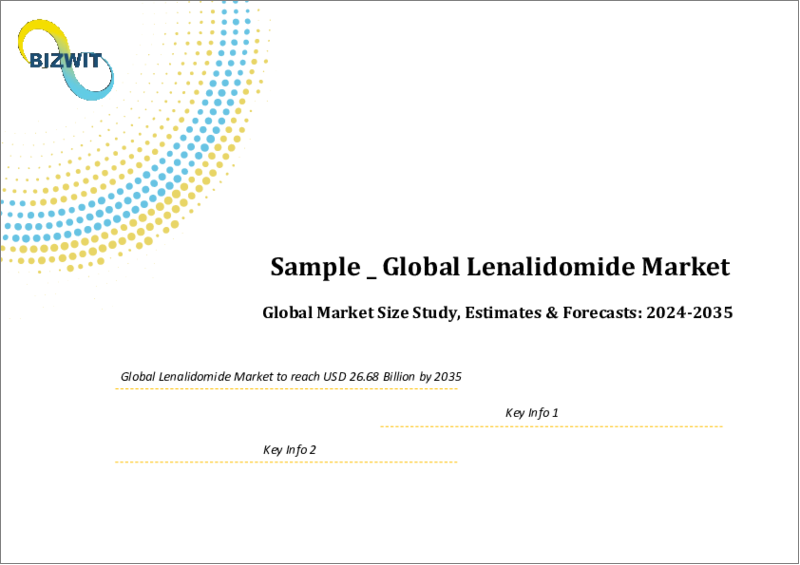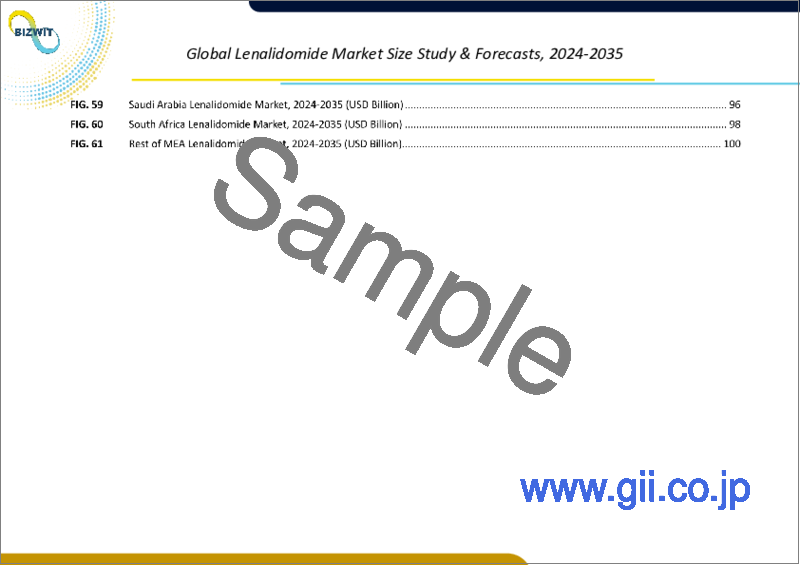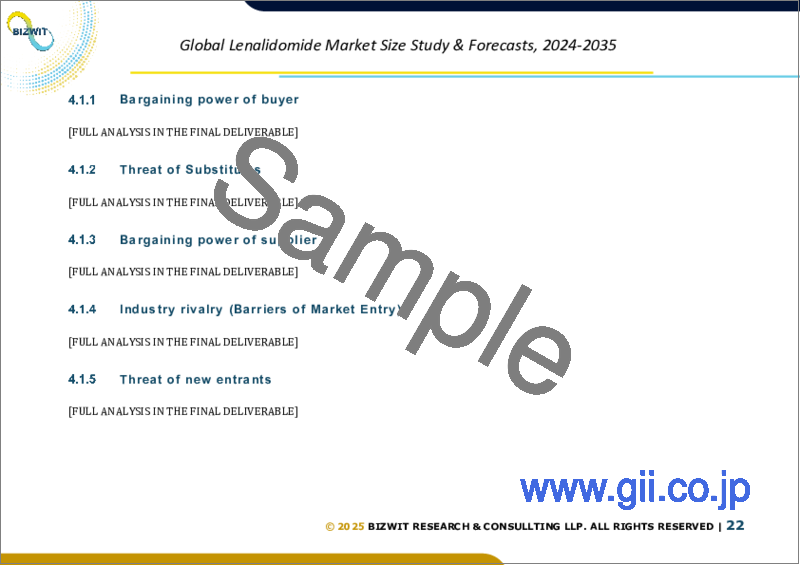|
|
市場調査レポート
商品コード
1735856
レナリドマイドの世界市場:市場規模の分析 (種類別、用途別、地域別) と将来予測 (2022~2032年)Global Lenalidomide Market Size study, by Type (5mg Capsules, 10mg Capsules, 15 mg Capsules, 25 mg Capsules), by Application, and Regional Forecasts 2022-2032 |
||||||
カスタマイズ可能
|
|||||||
| レナリドマイドの世界市場:市場規模の分析 (種類別、用途別、地域別) と将来予測 (2022~2032年) |
|
出版日: 2025年05月25日
発行: Bizwit Research & Consulting LLP
ページ情報: 英文 285 Pages
納期: 2~3営業日
|
全表示
- 概要
- 目次
世界のレナリドマイド市場は、2023年に約123億9,000万米ドルと評価され、予測期間中(2024~2032年)に6.60%以上の健全な成長率で成長すると予測されています。
サリドマイドの誘導体であるレナリドマイドは、多発性骨髄腫や骨髄異形成症候群を筆頭とする血液悪性腫瘍患者の治療状況を一変させました。抗炎症作用、抗血管新生作用、殺腫瘍作用で知られるこの免疫調節剤は、最前線と再発の両方の状況において、併用レジメンの要となることが多くなっています。経口単剤療法として、あるいは副腎皮質ステロイドやプロテアソーム阻害剤との相乗効果として投与できるこの薬剤の適応性により、腫瘍医は患者の忍容性やQOLを管理しながら治療成績を最適化できるようになりました。血液がんの世界の罹患率の上昇に伴い、レナリドマイドの臨床的意義はますます深まっています。
市場力学は、治療適応症の拡大からバイオシミラーやジェネリック医薬品の増加まで、さまざまな要因が複雑に絡み合って形成されています。製薬会社は、新用量(5mg、10mg、15mg、25mgカプセルなど)の登場や、特許の有効期間と商業的独占権を延長するための併用療法の拡大など、ライフサイクル・マネジメント戦略に厳格に取り組んでいます。さらに、レナリドマイドの固形がんや自己免疫疾患への応用の可能性を検討する臨床試験が進行中であることから、将来の市場展望が広がっています。しかし、価格圧力、高コストのがん治療に対する規制当局の監視、CAR-T療法などの新規薬剤との新たな競合が、持続的成長の障害となる可能性があります。
レナリドマイドの難治性・再発がん症例における有効性は十分に証明されており、がん専門医の間で採用が進んでいます。レナリドマイドを際立たせているのは、確かな臨床データだけでなく、経口投与であるため外来での使用が容易で患者の利便性が高いことです。複雑な生物学的製剤へのアクセスが限られている中低所得国では、ジェネリック医薬品の台頭が治療格差の是正に役立っています。一方、高所得国の医療制度は、アウトカムと費用対効果を重視するバリューベースのケアモデルへと移行しつつあり、レナリドマイドの長期的な経済価値に対する再評価を促しています。
地域的には、北米がレナリドマイド市場の最前線にあり続けています。これは、早期の医薬品承認、高度な診断インフラ、大手市場企業の強力なプレゼンスによるものです。特に米国は、多発性骨髄腫の罹患率が高く、がん治療に対する保険適用範囲が広いことから、引き続き主要な売上貢献国となっています。欧州は、有利な償還政策と高齢者がん人口の増加に支えられ、その後に続いています。アジア太平洋は、がん罹患率の増加、ヘルスケア投資の増加、インド、中国、日本などにおけるジェネリック医薬品へのアクセス拡大などを背景に、最も急成長している地域市場になる見通しです。
目次
第1章 世界のレナリドマイド市場:エグゼクティブサマリー
- 世界のレナリドマイドの市場規模と予測 (2022~2032年)
- 地域別概要
- セグメント別概要
- 種類別(5mg、10mg、15mg、25mgカプセル)
- 用途別
- 主要動向
- 景気後退の影響
- アナリストの提言と結論
第2章 世界のレナリドマイド市場:定義と分析の前提
- 分析目的
- 市場の定義
- 分析の前提
- 包含と除外
- 制限事項
- 供給サイド分析
- 可用性
- インフラ
- 規制枠組み
- 市場競争
- 経済性 (消費者の視点)
- 需要サイド分析
- 規制枠組み
- 技術進歩
- 環境への配慮
- 消費者の意識と受容
- 分析手法
- 分析対象期間
- 通貨換算レート
第3章 世界のレナリドマイド市場の力学
- 市場促進要因
- 造血悪性腫瘍の発生率の上昇
- 併用療法レジメンの拡大
- ジェネリック医薬品・バイオシミラーの導入の増加
- 市場の課題
- 高額な治療費と償還圧力
- 安全性と適応外使用に関する規制当局の精査
- 新規免疫療法(CAR-T、二重特異性抗体)との競合
- 市場機会
- 固形腫瘍および自己免疫疾患における新たな適応症
- アクセスの改善によるアジア太平洋への拡大
- 新しい投与量と処方によるライフサイクル管理
第4章 世界のレナリドマイド市場:産業分析
- ポーターのファイブフォースモデル
- 供給企業の交渉力
- 買い手の交渉力
- 新規参入業者の脅威
- 代替品の脅威
- 競争企業間の敵対関係
- ポーターのファイブフォースモデルへの将来的アプローチ
- ポーターのファイブフォースの影響分析
- PESTEL分析
- 政治的要因
- 経済的要因
- 社会的要因
- 技術的要因
- 環境的要因
- 法的要因
- 主な投資機会
- 主要成功戦略
- ディスラプションの動向
- 業界専門家の視点
- アナリストの提言と結論
第5章 世界のレナリドマイドの市場規模と予測:種類別 (2022~2032年)
- セグメントダッシュボード
- 5mgカプセル:収益動向分析(2022年・2032年)
- 10mgカプセル:収益動向分析(2022年・2032年)
- 15mgカプセル:収益動向分析(2022年・2032年)
- 25mgカプセル:収益動向分析(2022年・2032年)
第6章 世界のレナリドマイドの市場規模と予測:用途別 (2022~2032年)
- セグメントダッシュボード
- 多発性骨髄腫:収益動向分析(2022年・2032年)
- 骨髄異形成症候群:収益動向分析(2022年・2032年)
- その他:収益動向分析(2022年・2032年)
第7章 世界のレナリドマイドの市場規模と予測:地域別 (2022~2032年)
- 北米
- 米国市場
- カナダ市場(2022-2032)
- 欧州
- 英国市場
- ドイツ市場
- フランス市場
- スペイン市場
- イタリア市場
- その他欧州市場
- アジア太平洋
- 中国市場
- インド市場
- 日本市場
- オーストラリア市場
- 韓国市場
- その他アジア太平洋市場
- ラテンアメリカ
- ブラジル市場
- メキシコ市場
- その他ラテンアメリカ市場
- 中東・アフリカ
- サウジアラビア市場
- 南アフリカ市場
- その他中東・アフリカ市場
第8章 競合情報
- 主要企業のSWOT分析
- Celgene Corporation(BMS)
- Natco Pharma Ltd.
- Cipla Ltd.
- 主要市場の戦略
- 企業プロファイル
- Celgene Corporation(Bristol-Myers Squibb)
- 主要情報
- 概要
- 財務(データの入手可能性によります)
- 製品概要
- 市場戦略
- Natco Pharma Ltd.
- Cipla Ltd.
- Dr. Reddy's Laboratories Ltd.
- Sun Pharmaceutical Industries Ltd.
- Teva Pharmaceutical Industries Ltd.
- Aurobindo Pharma Ltd.
- Intas Pharmaceuticals Ltd.
- Mylan N.V.
- Glenmark Pharmaceuticals Ltd.
- Apotex Inc.
- Zydus Lifesciences Ltd.
- Lupin Pharmaceuticals, Inc.
- Novartis AG
- Hikma Pharmaceuticals PLC
- Celgene Corporation(Bristol-Myers Squibb)
第9章 分析プロセス
- 分析プロセス
- データマイニング
- 分析
- 市場予測
- 検証
- 刊行
- 分析の属性
Global Lenalidomide Market is valued approximately at USD 12.39 billion in 2023 and is anticipated to grow with a healthy growth rate of more than 6.60% over the forecast period 2024-2032. Lenalidomide, a derivative of thalidomide, has transformed the therapeutic landscape for patients suffering from hematologic malignancies, most notably multiple myeloma and myelodysplastic syndromes. This immunomodulatory agent, known for its anti-inflammatory, anti-angiogenic, and tumoricidal properties, has increasingly become the cornerstone of combination regimens across both frontline and relapsed settings. The drug's adaptability in being administered as oral monotherapy or in synergy with corticosteroids and proteasome inhibitors has allowed oncologists to optimize treatment outcomes while managing patient tolerance and quality of life. As the global incidence of blood cancers rises, Lenalidomide's clinical relevance continues to deepen.
Market dynamics are being shaped by a potent mix of factors ranging from the broadening scope of therapeutic indications to the increasing availability of biosimilar and generic alternatives. Pharmaceutical companies are rigorously engaged in lifecycle management strategies including the introduction of new dosages (such as 5mg, 10mg, 15mg, and 25mg capsules) and extended combination therapies to extend patent longevity and commercial exclusivity. Furthermore, ongoing clinical trials investigating Lenalidomide's potential applications in solid tumors and autoimmune conditions suggest an expanding future market horizon. However, pricing pressures, regulatory scrutiny on high-cost oncology treatments, and emerging competition from novel agents such as CAR-T therapies may present roadblocks to sustained growth.
Lenalidomide's well-documented efficacy in refractory and relapsed cancer cases continues to bolster its adoption among oncologists. What sets it apart is not only its robust clinical data but also its oral administration-offering ease of use and patient convenience in outpatient settings. In low- and middle-income countries, where access to complex biologics may be limited, the rise of generic lenalidomide is helping bridge treatment disparities. Meanwhile, health systems in high-income countries are transitioning toward value-based care models that emphasize outcomes and cost-effectiveness, prompting renewed evaluations of Lenalidomide's long-term economic value.
Geographically, North America remains at the forefront of the Lenalidomide market owing to early drug approvals, advanced diagnostic infrastructure, and a strong presence of major market players. The United States, in particular, continues to be a key revenue contributor driven by a high burden of multiple myeloma and broad insurance coverage for cancer therapies. Europe follows closely, underpinned by favorable reimbursement policies and growing geriatric cancer demographics. Asia Pacific is poised to emerge as the fastest-growing regional market, driven by increasing cancer prevalence, rising healthcare investments, and expanded access to generics in markets like India, China, and Japan.
Major market player included in this report are:
- Celgene Corporation (a Bristol-Myers Squibb Company)
- Natco Pharma Ltd.
- Cipla Ltd.
- Dr. Reddy's Laboratories Ltd.
- Sun Pharmaceutical Industries Ltd.
- Teva Pharmaceutical Industries Ltd.
- Aurobindo Pharma Ltd.
- Intas Pharmaceuticals Ltd.
- Mylan N.V.
- Glenmark Pharmaceuticals Ltd.
- Apotex Inc.
- Zydus Lifesciences Ltd.
- Lupin Pharmaceuticals, Inc.
- Novartis AG
- Hikma Pharmaceuticals PLC
The detailed segments and sub-segment of the market are explained below:
By Type
- 5mg Capsules
- 10mg Capsules
- 15mg Capsules
- 25mg Capsules
By Application
- Multiple Myeloma
- Myelodysplastic Syndromes
- Others
By Region:
- North America
- U.S.
- Canada
- Europe
- UK
- Germany
- France
- Spain
- Italy
- Rest of Europe
- Asia Pacific
- China
- India
- Japan
- Australia
- South Korea
- Rest of Asia Pacific
- Latin America
- Brazil
- Mexico
- Rest of Latin America
- Middle East & Africa
- Saudi Arabia
- South Africa
- Rest of Middle East & Africa
Years considered for the study are as follows:
- Historical year - 2022
- Base year - 2023
- Forecast period - 2024 to 2032
Key Takeaways:
- Market Estimates & Forecast for 10 years from 2022 to 2032.
- Annualized revenues and regional level analysis for each market segment.
- Detailed analysis of geographical landscape with country-level analysis of major regions.
- Competitive landscape with information on major players in the market.
- Analysis of key business strategies and recommendations on future market approach.
- Analysis of competitive structure of the market.
- Demand side and supply side analysis of the market.
Table of Contents
Chapter 1. Global Lenalidomide Market Executive Summary
- 1.1. Global Lenalidomide Market Size & Forecast (2022-2032)
- 1.2. Regional Summary
- 1.3. Segmental Summary
- 1.3.1. By Type (5mg, 10mg, 15mg, 25mg Capsules)
- 1.3.2. By Application
- 1.4. Key Trends
- 1.5. Recession Impact
- 1.6. Analyst Recommendation & Conclusion
Chapter 2. Global Lenalidomide Market Definition and Research Assumptions
- 2.1. Research Objective
- 2.2. Market Definition
- 2.3. Research Assumptions
- 2.3.1. Inclusion & Exclusion
- 2.3.2. Limitations
- 2.3.3. Supply Side Analysis
- 2.3.3.1. Availability
- 2.3.3.2. Infrastructure
- 2.3.3.3. Regulatory Environment
- 2.3.3.4. Market Competition
- 2.3.3.5. Economic Viability (Consumer's Perspective)
- 2.3.4. Demand Side Analysis
- 2.3.4.1. Regulatory Frameworks
- 2.3.4.2. Technological Advancements
- 2.3.4.3. Environmental Considerations
- 2.3.4.4. Consumer Awareness & Acceptance
- 2.4. Estimation Methodology
- 2.5. Years Considered for the Study
- 2.6. Currency Conversion Rates
Chapter 3. Global Lenalidomide Market Dynamics
- 3.1. Market Drivers
- 3.1.1. Rising incidence of hematologic malignancies
- 3.1.2. Expansion of combination therapy regimens
- 3.1.3. Growth of generic and biosimilar introductions
- 3.2. Market Challenges
- 3.2.1. High treatment costs and reimbursement pressures
- 3.2.2. Regulatory scrutiny on safety and off-label use
- 3.2.3. Competition from novel immunotherapies (CAR-T, bispecifics)
- 3.3. Market Opportunities
- 3.3.1. Emerging indications in solid tumors and autoimmune diseases
- 3.3.2. Expansion in Asia Pacific due to improving access
- 3.3.3. Lifecycle management via new dosage strengths and formulations
Chapter 4. Global Lenalidomide Market Industry Analysis
- 4.1. Porter's Five Forces Model
- 4.1.1. Bargaining Power of Suppliers
- 4.1.2. Bargaining Power of Buyers
- 4.1.3. Threat of New Entrants
- 4.1.4. Threat of Substitutes
- 4.1.5. Competitive Rivalry
- 4.1.6. Futuristic Approach to Porter's Model
- 4.1.7. Impact Analysis
- 4.2. PESTEL Analysis
- 4.2.1. Political
- 4.2.2. Economic
- 4.2.3. Social
- 4.2.4. Technological
- 4.2.5. Environmental
- 4.2.6. Legal
- 4.3. Top Investment Opportunities
- 4.4. Top Winning Strategies
- 4.5. Disruptive Trends
- 4.6. Industry Expert Perspectives
- 4.7. Analyst Recommendation & Conclusion
Chapter 5. Global Lenalidomide Market Size & Forecasts by Type (2022-2032)
- 5.1. Segment Dashboard
- 5.2. 5mg Capsules Revenue Trend Analysis, 2022 & 2032
- 5.3. 10mg Capsules Revenue Trend Analysis, 2022 & 2032
- 5.4. 15mg Capsules Revenue Trend Analysis, 2022 & 2032
- 5.5. 25mg Capsules Revenue Trend Analysis, 2022 & 2032
Chapter 6. Global Lenalidomide Market Size & Forecasts by Application (2022-2032)
- 6.1. Segment Dashboard
- 6.2. Multiple Myeloma Revenue Trend Analysis, 2022 & 2032
- 6.3. Myelodysplastic Syndromes Revenue Trend Analysis, 2022 & 2032
- 6.4. Others Revenue Trend Analysis, 2022 & 2032
Chapter 7. Global Lenalidomide Market Size & Forecasts by Region (2022-2032)
- 7.1. North America Lenalidomide Market
- 7.1.1. U.S. Market (2022-2032)
- 7.1.2. Canada Market (2022-2032)
- 7.2. Europe Lenalidomide Market
- 7.2.1. U.K. Market
- 7.2.2. Germany Market
- 7.2.3. France Market
- 7.2.4. Spain Market
- 7.2.5. Italy Market
- 7.2.6. Rest of Europe Market
- 7.3. Asia Pacific Lenalidomide Market
- 7.3.1. China Market
- 7.3.2. India Market
- 7.3.3. Japan Market
- 7.3.4. Australia Market
- 7.3.5. South Korea Market
- 7.3.6. Rest of Asia Pacific Market
- 7.4. Latin America Lenalidomide Market
- 7.4.1. Brazil Market
- 7.4.2. Mexico Market
- 7.4.3. Rest of Latin America Market
- 7.5. Middle East & Africa Lenalidomide Market
- 7.5.1. Saudi Arabia Market
- 7.5.2. South Africa Market
- 7.5.3. Rest of Middle East & Africa Market
Chapter 8. Competitive Intelligence
- 8.1. Key Company SWOT Analysis
- 8.1.1. Celgene Corporation (BMS)
- 8.1.2. Natco Pharma Ltd.
- 8.1.3. Cipla Ltd.
- 8.2. Top Market Strategies
- 8.3. Company Profiles
- 8.3.1. Celgene Corporation (Bristol-Myers Squibb)
- 8.3.1.1. Key Information
- 8.3.1.2. Overview
- 8.3.1.3. Financial (Subject to Data Availability)
- 8.3.1.4. Product Summary
- 8.3.1.5. Market Strategies
- 8.3.2. Natco Pharma Ltd.
- 8.3.3. Cipla Ltd.
- 8.3.4. Dr. Reddy's Laboratories Ltd.
- 8.3.5. Sun Pharmaceutical Industries Ltd.
- 8.3.6. Teva Pharmaceutical Industries Ltd.
- 8.3.7. Aurobindo Pharma Ltd.
- 8.3.8. Intas Pharmaceuticals Ltd.
- 8.3.9. Mylan N.V.
- 8.3.10. Glenmark Pharmaceuticals Ltd.
- 8.3.11. Apotex Inc.
- 8.3.12. Zydus Lifesciences Ltd.
- 8.3.13. Lupin Pharmaceuticals, Inc.
- 8.3.14. Novartis AG
- 8.3.15. Hikma Pharmaceuticals PLC
- 8.3.1. Celgene Corporation (Bristol-Myers Squibb)
Chapter 9. Research Process
- 9.1. Research Process
- 9.1.1. Data Mining
- 9.1.2. Analysis
- 9.1.3. Market Estimation
- 9.1.4. Validation
- 9.1.5. Publishing
- 9.2. Research Attributes





